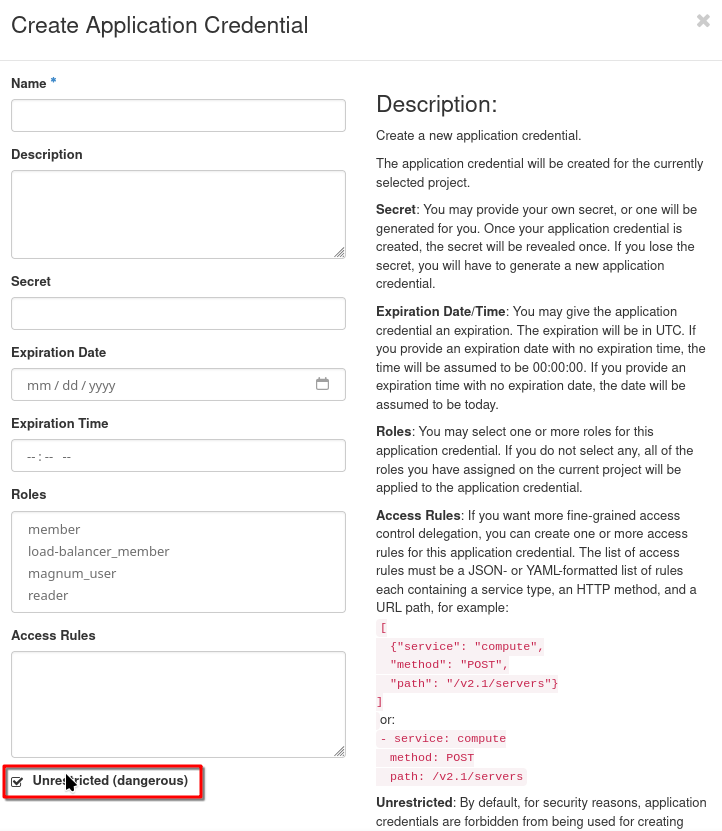Configuring IP Whitelisting for OpenStack Load Balancer using Terraform on Eumetsat Elasticity
This guide explains how to configure IP whitelisting (allowed_cidrs) on an existing OpenStack Load Balancer using Terraform. The configuration will limit access to your cluster through load balancer.
What We Are Going To Cover
Get necessary load balancer and cluster data from the Prerequisites
Create the Terraform Configuration
Import Existing Load Balancer Listener
Run terraform
Test and verify that protection of load balancer via whitelisting works
Prerequisites
No. 1 Account
You need a Eumetsat Elasticity hosting account with access to the Horizon interface: https://horizon.cloudferro.com/auth/login/?next=/.
No. 2 Basic parameters already defined for whitelisting
See article Configuring IP Whitelisting for OpenStack Load Balancer using Horizon and CLI on Eumetsat Elasticity for definition of basic notions and parameters.
No. 3 Terraform installed
You will need version 1.50 or higher to be operational.
For complete introduction and installation of Terrafom on OpenStack see article Generating and authorizing Terraform using Keycloak user on Eumetsat Elasticity
No. 4 Unrestricted application credentials
You need to have OpenStack application credentials with unrestricted checkbox. Check article How to generate or use Application Credentials via CLI on Eumetsat Elasticity
The first part of that article describes how to have installed OpenStack client and connect it to the cloud. With that provision, the quickest way to create an unrestricted application credential is to apply the command like this:
openstack application credential create cred_unrestricted --unrestricted
That would create an unrestricted credential called cred_unrestricted.
You can also use Horizon commands Identity –> Application Credentials –> Create Application Credential and check the appropriate box on:

Log in to your account using this unrestricted credential.
Prepare Your Environment
Work through article in Prerequisite No. 2 from which we will derive all the input parameters, using Horizon and CLI commands.
Also, authenticate through application credential you got from Prerequisite No. 4.
Configure Terraform for whitelisting
Instead of performing the whitelisting procedure manually, we can use Terraform and store the procedure in the remote repo.
Create file openstack_auth.sh
export OS_AUTH_URL="https://your-openstack-url:5000/v3"
export OS_PROJECT_NAME="your-project"
export OS_USERNAME="your-username"
export OS_PASSWORD="your-password"
export OS_REGION_NAME="your-region"
Create a new directory for your Terraform configuration and create the following files:
Note
This example is created for brand new Magnum cluster. You might have to adjust it a bit to suit your needs.
Create Terraform file:
main.tf
terraform {
required_providers {
openstack = {
source = "terraform-provider-openstack/openstack"
version = "1.47.0"
}
}
}
provider "openstack" {
use_octavia = true # Required for Load Balancer v2 API
}
variables.tf
variable "ID_OF_LOADBALANCER" {
type = string
description = "ID of the existing OpenStack Load Balancer"
}
variable "allowed_cidrs" {
type = list(string)
description = "List of IP ranges in CIDR format to whitelist"
}
terraform.tfvars
ID_OF_LOADBALANCER = "your-lb-id"
allowed_cidrs = [
"10.0.0.1/32", # Single IP address
"192.168.1.0/24", # IP range
"172.16.0.0/16" # Larger subnet
]
lb.tf
resource "openstack_lb_listener_v2" "k8s_api_listener" {
loadbalancer_id = var.ID_OF_LOADBALANCER
allowed_cidrs = var.allowed_cidrs
protocol_port = "6443"
protocol = "TCP"
}
Import Existing Load Balancer Listener
Since Terraform 1.5 can import your resource in declarative way.
import.tf
import {
to = openstack_lb_listener_v2.k8s_api_listener
id = "your-listener-id"
}
Or you can do it in an imperative way:
terraform import openstack_lb_listener_v2.k8s_api_listener "<your-listener-id>"
Run Terraform
Terraform Execute
terraform init
terraform plan -out=generated_listener.tf
terraform apply generated_listener.tf
Example output:
teraform output
Terraform apply generated_listener.tf
openstack_lb_listener_v2.k8s_api_listener: Preparing import... [id=bbf39f1c-6936-4344-9957-7517d4a979b6]
openstack_lb_listener_v2.k8s_api_listener: Refreshing state... [id=bbf39f1c-6936-4344-9957-7517d4a979b6]
Terraform used the selected providers to generate the following execution
plan. Resource actions are indicated with the following symbols:
~ update in-place
Terraform will perform the following actions:
# openstack_lb_listener_v2.k8s_api_listener will be updated in-place
# (imported from "bbf39f1c-6936-4344-9957-7517d4a979b6")
~ resource "openstack_lb_listener_v2" "k8s_api_listener" {
admin_state_up = true
~ allowed_cidrs = [
+ "10.0.0.1/32",
]
connection_limit = -1
default_pool_id = "5991eacc-5869-4205-a646-d27646ccb216"
default_tls_container_ref = null
description = null
id = "bbf39f1c-6936-4344-9957-7517d4a979b6"
insert_headers = {}
loadbalancer_id = "2d6b335f-fb05-4496-8593-887f7e2c49cf"
name = "lb-testing-ih347dstxyl2-api_lb_fixed-w2im3obvdv2p-listener-t36tocd4onxk"
protocol = "TCP"
protocol_port = 6443
region = "<concealed by 1Password>"
sni_container_refs = []
tenant_id = "<concealed by 1Password>"
timeout_client_data = 50000
timeout_member_connect = 5000
timeout_member_data = 50000
timeout_tcp_inspect = 0
- timeouts {}
}
Plan: 1 to import, 0 to add, 1 to change, 0 to destroy.
Tests
By default, Magnum LB does not have any access restrictions.
Before changes:
curl -k https://<KUBE_API_IP>:6443/livez?verbose
[+]ping ok
[+]log ok
[+]etcd ok
[+]poststarthook/start-kube-apiserver-admission-initializer ok
[+]poststarthook/generic-apiserver-start-informers ok
[+]poststarthook/priority-and-fairness-config-consumer ok
[+]poststarthook/priority-and-fairness-filter ok
[+]poststarthook/storage-object-count-tracker-hook ok
[+]poststarthook/start-apiextensions-informers ok
[+]poststarthook/start-apiextensions-controllers ok
[+]poststarthook/crd-informer-synced ok
[+]poststarthook/start-system-namespaces-controller ok
[+]poststarthook/bootstrap-controller ok
[+]poststarthook/rbac/bootstrap-roles ok
[+]poststarthook/scheduling/bootstrap-system-priority-classes ok
[+]poststarthook/priority-and-fairness-config-producer ok
[+]poststarthook/start-cluster-authentication-info-controller ok
[+]poststarthook/start-kube-apiserver-identity-lease-controller ok
[+]poststarthook/start-deprecated-kube-apiserver-identity-lease-garbage-collector ok
[+]poststarthook/start-kube-apiserver-identity-lease-garbage-collector ok
[+]poststarthook/start-legacy-token-tracking-controller ok
[+]poststarthook/aggregator-reload-proxy-client-cert ok
[+]poststarthook/start-kube-aggregator-informers ok
[+]poststarthook/apiservice-registration-controller ok
[+]poststarthook/apiservice-status-available-controller ok
[+]poststarthook/kube-apiserver-autoregistration ok
[+]autoregister-completion ok
[+]poststarthook/apiservice-openapi-controller ok
[+]poststarthook/apiservice-openapiv3-controller ok
[+]poststarthook/apiservice-discovery-controller ok
livez check passed
After:
curl -k https://<KUBE_API_IP>:6443/livez?verbose -m 5
curl: (28) Connection timed out after 5000 milliseconds
What To Do Next
Compare with Implementing IP Whitelisting for Load Balancers with Security Groups on Eumetsat Elasticity